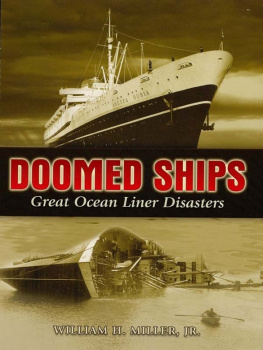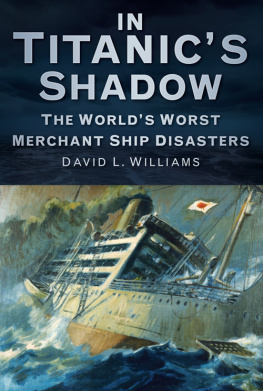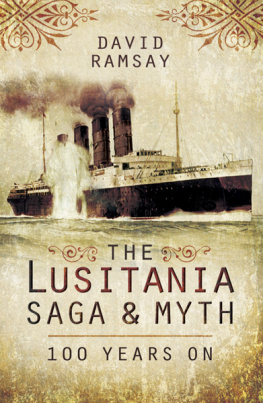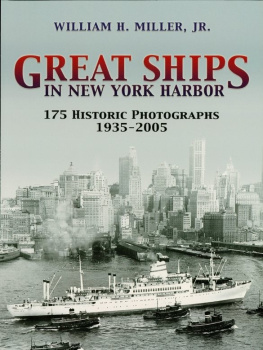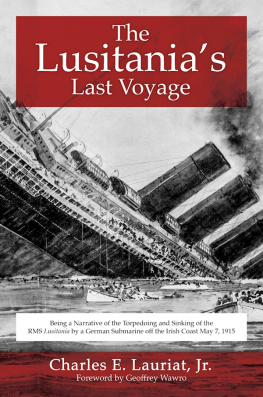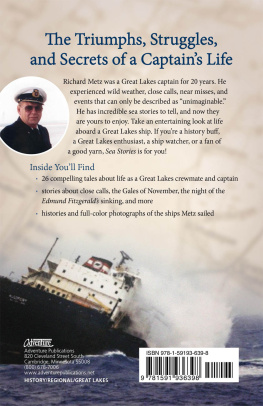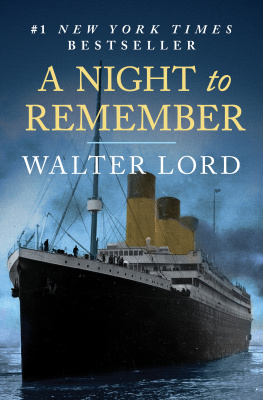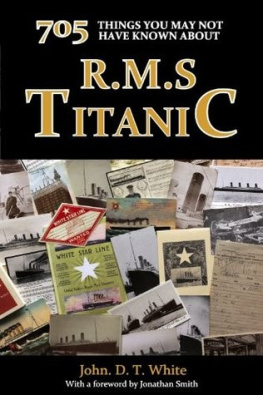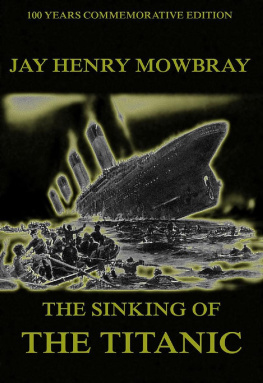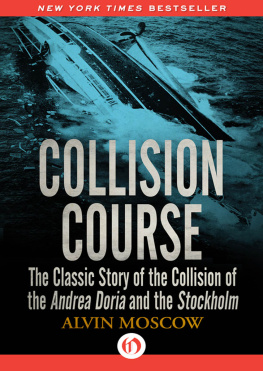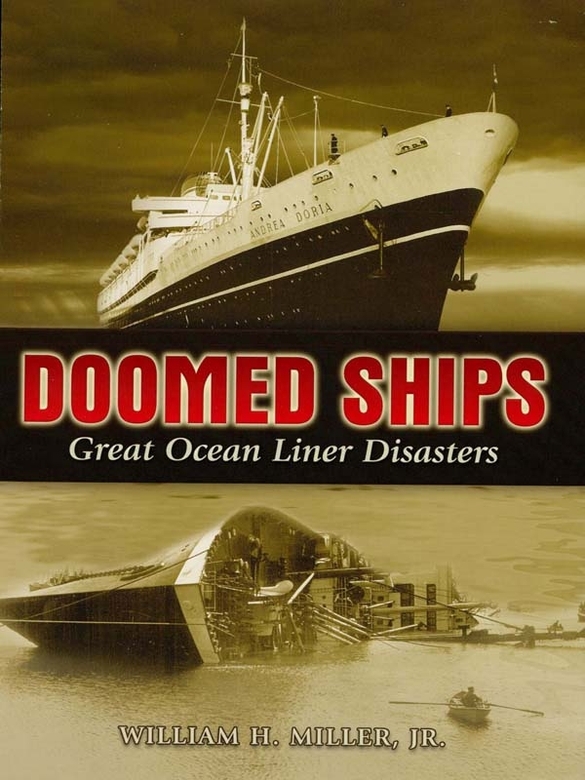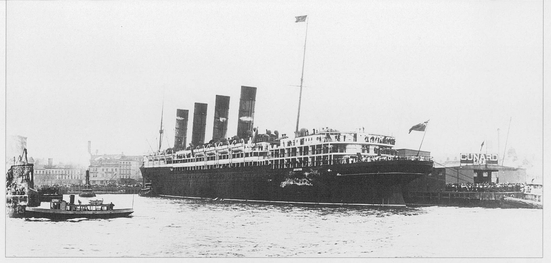ACKNOWLEDGMENTS
Once again, many hands, including the crew, have been involved in the compilation of this book. Anecdotes and photos were collected, sorted, and then worked into the project. As expected, locating support material for some of the ships proved more challenging than others. I remain most grateful to so many friends, who, in kindness, generosity, and often with great patience, were ready to assist. Together we believe that passenger shipsparticularly bygone onesmust be kept alive. Documentation in books is one of the very best ways to do this. And so, we are most grateful to Dover Publications for suggesting this title. Dover produces excellent, high-quality, affordable books. My association with them, which began in 1979, happily continues. The connection started with the late Hayward Cirker, the founder of Dover, at the companys former offices located in lower Manhattan on Varick Street. Sparked by his own Atlantic crossings by liner in the 1930s, Mr. Cirker was intrigued by maritime topics. Thanks to his interest and foresight, we have produced some twenty books together. I am especially grateful to the present staff at Dover (now in Mineola, Long Island): Clarence Strowbridge, for suggesting new titles and accepting others; Suzanne E. Johnson, for her editorial skills and great sense of accuracy and detail; and Carol Belanger Grafton, for her splendid design and layout.
Apart from Dover, the crew is really quite sizeable. I am particularly grateful to Richard Faber for providing photographs and other materials for all of my books, and to Peter Knego for his thoughtful Foreword and his much-appreciated support, photographs, and personal recollections. Also, the highest praises to Abe Michaelson, my business partner, who promotes, sells, and distributes books to the four corners of the earth. In addition, my warmest thanks to the late Frank Andrews, Ernest Arroyo, Frank Braynard, Philippe Brebant, J. K. Byass, Michael Cassar, Tom Cassidy, Anthony Cooke, Luis Miguel Correia, the late Frank Cronican, Arthur Crook, Frank Duffy, the late Alex Duncan, Maurizio Eliseo, James and Tina Flood, the late John Gillespie, Dr. Nico Guns, Andy Hernandez, Charles Howland, Bob Kemelhor, Arnold Kludas, Bard Kolltviet, Stan Lehrer, Robert Lenzer, Victor Marinelli, Captain James McNamara, Richard Morse, Carl Netherland-Brown, Hisashi Noma, Robert Pelletier, Paolo Piccione, Fred Rodriguez, Rich Romano, Jurgen Saupe, Roger Scozzafava, the late Antonio Scrimali, James L. Shaw, Captain Ed Squire, Steven Tacey, Frank Trumbour, the late Everett Viez, Al Wilhelmi, Steven Winograd, Hans Jurgen Witthoft, James Wheeler, V. H. Young, and L. A. Sawyer.
Firms and organizations that greatly assisted include British India Line, Carmania Press Limited, Carnival Cruise Lines, Celebrity Cruises, Crystal Cruises, Cunard Line, Hapag-Lloyd, Hoboken Historical Museum, Moran Towing & Transportation Company, the Ocean Liner Council at the South Street Seaport Museum, Port Authority of New York & New Jersey, RadissonSeven Seas Cruises, Royal Mail Lines, South China Morning Post, Steamship Historical Society of America (especially the Long Island Chapter), the U.S. Merchant Marine Museum, World Ocean & Cruise Society, and the World Ship Society (most notably the Port of New York Branch). There are also companies that are, alas, no more, such as Bethlehem Steel Company and Flying Camera, Inc. If I have failed to mention anyone else, my great apologies. But know that you are all well appreciated and have assisted in keeping a part of our maritime history alive.
BIBLIOGRAPHY
Bonsor, N. R. P. North Atlantic Seaway. Prescot, Lancashire: T. Stephenson & Sons Ltd., 1955.
Cooke, Anthony. Emigrant Ships. London: Carmania Press Ltd., 1992.
Crowdy, Michael and Kevin ODonoghue, eds. Marine News . Kendal, Cumbria: World Ship Society, 19642005.
Devol, George, ed. Ocean & Cruise News. Stamford, Connecticut: World Ocean & Cruise Society, 19802005.
Dunn, Laurence. Passenger Liners. Southampton, England: Adlard Coles Ltd., 1961.
. Passengers Liners (revised edition). Southampton, England: Adlard Coles Ltd., 1965.
Durand, Jean-Franois. Cruise Ships Around the World. Nantes, France: Marine Editions, 1997.
Eisele. Peter and William Rau, eds. Steamboat Bill, Providence, Rhode Island: Steamship Historical Society of America Inc., 19642005.
Haws, Duncan. Merchant Fleets: Cunard Line. Hereford, England: TCL Publications, 1987.
Horndby, David. Ocean Ships. Shepperton, England: Ian Allan Ltd., 2000.
Kludas, Arnold. Die grossen Passagier-Schiffe der Welt. Hamburg, Germany: Koehlers Verlagsgesellschaft mbH, 1997.
. Great Passenger Ships of the World, Volumes 15. Cambridge, England: Patrick Stephens Ltd, 197276.
. Great Passenger Ships of the World, Volume 6. Cambridge, England: Patrick Stephens Ltd, 1986.
. Great Passenger Ships of the World Today. Sparkford, England: Patrick Stephens Ltd., 1992.
Miller, William H. The Cruiseships. London: Conway Maritime Press Ltd., 1988.
. The Last Atlantic Liners . London: Conway Maritime Press Ltd., 1985.
. The Last Blue Water Liners. London: Conway Maritime Press Ltd., 1986.
. Pictorial Encyclopedia of Ocean Liners , 18601994. Mineola, New York: Dover Publications Inc., 1995.
. Transatlantic Liners 19451980. Newton Abbot, Devon: David & Charles Ltd.. 1981.
. Passenger Liners American Style. London: Carmania Press Ltd., 1999.
. Passenger Liners French Style . London: Carmania Press Ltd., 2000.
Tzamtzis, A. I. The Greek Ocean Liners 19071977. Alimos, Greece: Militos Editions, 1998.
Worker, Colin. The Worlds Passenger Ships. London: Ian Allan Ltd.. 1967.
LUSITANIA . The Lusitania came from the golden age of Atlantic liners. She was a true superliner, a near sister to the immensely successful, long-lived, and thoroughly beloved Mauretania , which sailed from 1907 until 1934. The latter ship had further claim to fame: she held the coveted Blue Riband for transoceanic speed for twenty-two years (1907 until 1929). Launched at the illustrious John Brown yard along Scotlands River Clyde, the Lucy, as she was dubbed, entered service in September 1907 and briefly captured the Blue Riband herself. She sailed in the Cunard Lines main express service, crossing between Liverpool and New York in six days. She is seen here ( above ) at Cunards West 14th Street pier in Manhattan. Capped by four towering funnels, she was typically class-divided for her time. This view ( below ) showing her first-class lounge hints of her finer luxuries.
Popular, well run, and a true North Atlantic favorite, the Lusitania became known for her part in one of the greatest ocean disasters. Hers was a wartime tragedy in the first dark year of World War I, the war that was to end all wars. The Lusitania was considered for alternative military service from her inception, and was given a secret refit in 1913a year before the war began. Her fore-decks were fitted with magazines (storage areas for ammunition). When war was officially declared in August 1914, the British Admiralty enlisted the Lusitania as an armed auxiliary cruiser. At the same time, she continued her peacetime service, sailing on monthly round-trip voyages between New York and Liverpool. Her sailings lasted into 1915, even after the Germans openly announced that all shipping around the British Isles was liable to attack. Nevertheless, the giant Lusitania steamed on, carrying regular passengers, as well as supposed general cargo.

